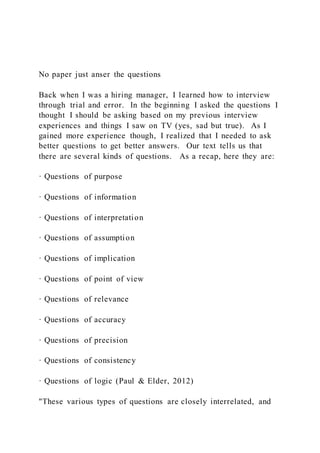No paper just anser the questionsBack when I was a hiring ma
No paper just anser the questions Back when I was a hiring manager, I learned how to interview through trial and error. In the beginning I asked the questions I thought I should be asking based on my previous interview experiences and things I saw on TV (yes, sad but true). As I gained more experience though, I realized that I needed to ask better questions to get better answers. Our text tells us that there are several kinds of questions. As a recap, here they are: · Questions of purpose · Questions of information · Questions of interpretation · Questions of assumption · Questions of implication · Questions of point of view · Questions of relevance · Questions of accuracy · Questions of precision · Questions of consistency · Questions of logic (Paul & Elder, 2012) "These various types of questions are closely interrelated, and an effective thinker is able to use them productively in relation to one another" (Chafee, 2012). Think about the questions you ask. Think about the types of questions I ask. In reviewing those questions, what types of questions were they? Why do you select the category(ies) you did? Why is it important to know about and use the various types of questions? Reference: Chafee, J. (2012). Thinking critically (10th ed.). Boston, MA: Wadsworth. Paul, R., & Elder, L. (2012). Critical thinking: Tools for taking charge of your learning and your life (3rd ed.). Boston, MA: Pearson. In this video, the highlight is on rhetoric, which is all about the art of persuasion. While it is closely linked to logic and reason, it uses appeal to emotion and focuses on "getting an audience to agree with and act on what we have persuaded them to consider" (Pearson Learning Solution s, 2014). There are 3 goals for rhetoric: · To teach · To move · To delight (Pearson Learning ...

Recommended
Recommended
More Related Content
More from tangelae6x
More from tangelae6x (20)
No paper just anser the questionsBack when I was a hiring ma
- 1. No paper just anser the questions Back when I was a hiring manager, I learned how to interview through trial and error. In the beginning I asked the questions I thought I should be asking based on my previous interview experiences and things I saw on TV (yes, sad but true). As I gained more experience though, I realized that I needed to ask better questions to get better answers. Our text tells us that there are several kinds of questions. As a recap, here they are: · Questions of purpose · Questions of information · Questions of interpretation · Questions of assumption · Questions of implication · Questions of point of view · Questions of relevance · Questions of accuracy · Questions of precision · Questions of consistency · Questions of logic (Paul & Elder, 2012) "These various types of questions are closely interrelated, and
- 2. an effective thinker is able to use them productively in relation to one another" (Chafee, 2012). Think about the questions you ask. Think about the types of questions I ask. In reviewing those questions, what types of questions were they? Why do you select the category(ies) you did? Why is it important to know about and use the various types of questions? Reference: Chafee, J. (2012). Thinking critically (10th ed.). Boston, MA: Wadsworth. Paul, R., & Elder, L. (2012). Critical thinking: Tools for taking charge of your learning and your life (3rd ed.). Boston, MA: Pearson. In this video, the highlight is on rhetoric, which is all about the art of persuasion. While it is closely linked to logic and reason, it uses appeal to emotion and focuses on "getting an audience to agree with and act on what we have persuaded them to consider" (Pearson Learning Solution s, 2014). There are 3 goals for rhetoric: · To teach
- 3. · To move · To delight (Pearson Learning